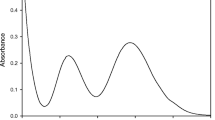Abstract
The synthesis, characterization, anti-hyperglycemic activity, oxidative DNA damage capacity, and acute toxicity of chromium(III) malate complex [Cr2(LMA)3] were described. [Cr2(LMA)3] was synthesized in a single-step reaction by chelating chromium(III) with L-malic acid in aqueous solution. Based on elemental analysis, thermodynamic analysis, and spectroscopy studies, the molecular formula of [Cr2(LMA)3] was inferred as Cr2(C4H4O5)3·5H2O. Daily treatment with 2.85–17.10 mg/kg body mass of [Cr2(LMA)3] in alloxan-induced diabetic rats for 2 weeks indicated that low-molecular-weight organic chromium complex [Cr2(LMA)3] had better bioavailability and more beneficial influences on the improvement of controlling blood glucose, serum lipid, and liver glycogen levels compared with CrCl3·6H2O. [Cr2(LMA)3] did not cause oxidative DNA damage under physiologically relevant conditions. Acute toxicity studies revealed no-measurable toxicity of the [Cr2(LMA)3]. Collectively, these results suggest that [Cr2(LMA)3] may represent a novel, proper chromium supplement with potential therapeutic value to control blood glucose and serum lipid in diabetes.






Similar content being viewed by others
References
Ghosh D, Bhattacharya B, Mukherjee B et al (2002) Role of chromium supplementation in Indians with type 2 diabetes mellitus. J Nutr Biochem 13:690–697
Morris BW, Kouta S, Robinson R et al (2000) Chromium supplementation improves insulin resistance in patients with Type 2 diabetes mellitus. Diabet Med 17:684–685
Preuss HG, Echard B, Perricone NV et al (2008) Comparing metabolic effects of six different commercial trivalent chromium compounds. J Inorg Biochem 102:1986–1990
Anderson RA (1997) Chromium as an essential nutrient for humans. Regul Toxicol Pharmacol 26:S35–S41
Sahina K, Ondercib M, Tuzcuc M et al (2007) Effect of chromium on carbohydrate and lipid metabolism in a rat model of type 2 diabetes mellitus: the fat-fed, streptozotocin-treated rat. Metab Clin Exp 56:1233–1240
Vincent JB (2001) The bioinorganic chemistry of chromium(III). Polyhedron 20:1–26
Vrtovec M, Vrtovec B, Briski A et al (2005) Chromium supplementation shortens QTc interval duration in patients with type 2 diabetes mellitus. Am Heart J 149:632–636
Besong S, Jackson JA, Trammell DS et al (2001) Influence of supplemental chromium on concentrations of liver triglyceride, blood metabolites and rumen VFA profile in steers fed a moderately high fat diet. J Dairy Sci Sci 84:1679–1685
Stallings DM, Hepburn DDD, Hannah M et al (2006) Nutritional supplement chromium picolinate generates chromosomal aberrations and impedes progeny development in Drosophila melanogaster. Mutat Res 610:101–113
Andersson MA, Petersson Grawe Kierstin V, Karlsson OM et al (2007) Evaluation of the potential genotoxicity of chromium picolinate in mammalian cells in vivo and in vitro. Food Chem Toxicol 45:1097–1106
Hepburn DDD, Marcel Burney J, Woski SA et al (2003) The nutritional supplement chromium picolinate generates oxidative DNA damage and peroxidized lipids in vivo. Polyhedron 22:455–463
Król E, Krejpcio Z (2010) Chromium(III) propionate complex supplementation improves carbohydrate metabolism in insulin-resistance rat model. Food Chem Toxicol 48:2791–2796
Staniek H, Kostrzewska-Poczekaj M, Arndt M et al (2010) Genotoxicity assessment of chromium(III) propionate complex in the rat model using the comet assay. Food Chem Toxicol 48:89–92
Staniek H, Krejpcio Z, Iwanik K (2010) Evaluation of the acute oral toxicity class of tricentric chromium(III) propionate complex in rat. Food Chem Toxicol 48:859–864
Bobyleva-Guarriero V, Wehbie RS, Lardy HA (1986) The role of malate in hormone-induced enhancement of mitochondrial respiration. Arch Biochem Biophys 245:477–482
Wu JL, Wu QP, Yang XF et al (2008) L-malate reverses oxidative stress and antioxidative defenses in liver and heart of aged rats. Physiol Res 57:261–268
Deburgos NMG, Gallina F, Burgos C et al (1994) Effect of L-malate on pyruvate-dehydrogenase activity of spermatozoa. Arch Biochem Biophys 308:520–524
Nair SA, Shylesh BS, Gopakumar B et al (2006) Anti-diabetes and hypoglycaemic properties of Hemionitis arifolia (Burm.) Moore in rats. J Ethnopharmacol 106:192–197
Buccolo G, David M (1973) Quantitative determination of serum triglycerides by use of enzyme. Clin Chem 19:476–482
Carroll NV, Longly RW, Joseph HR (1956) Determination of glycogen in liver and muscle by use of anthrone reagent. J Biol Chem 220:583–593
Hallwell B, Gutteridge JM, Aruoma OI (1987) The deoxyribose method: a simple “test-tube” assay for determination of rate constants for reactions of hydroxyl radicals. Anal Biochem 165:215–219
Hilaly JE, Israili ZH, Lyoussi B (2004) Acute and chronic toxicological studies of Ajuga iva in experimental animals. J Ethnopharmacol 91:43–50
Abdel-Monem MM, Mahamoud M, Anderson MD (2003) Novel chromium(III) alpha amino acid complexes. US patent: 0030228394
Yang X, Palanichamy K, Ontko AC et al (2005) A newly synthetic chromium complex—chromium(phenylalanine)3 improves insulin responsiveness and reduces whole body glucose tolerance. FEBS Lett 579:1458–1464
Kim D-S, Kim T-W, Park I-K et al (2002) Effects of chromium picolinate supplementation on insulin sensitivity, serum lipids, and body weight in dexamethasone-treated rats. Metabolism 51:589–594
Bordbar A-K, Creagh AL, Mohammadi F et al (2009) Calorimetric studies of the interaction between the insulin-enhancing drug candidate bis(maltolato)oxovanadium(IV) (BMOV) and human serum apo-transferrin. J Inorg Biochem 103:643–647
Yang X, Li S-Y, Dong F et al (2006) Insulin-sensitizing and cholesterol-lowering effects of chromium (D-Phenylalanine)3. J Inorg Biochem 100:1187–1193
Vincent JB (2004) Recent advances in the nutritional biochemistry of trivalent chromium. Proc Nutr Soc 63:41–47
Hepburn DD, Vincent JB (2002) In vivo distribution of chromium from chromium picolinate in rats and implications for the safety of the dietary supplement. Chem Res Toxicol 15:93–100
Alexeeff GV, Broadwin R, Liaw J et al (2002) Characterization of the LOAEL-to-NOAEL uncertainty factor for mild adverse effects from acute inhalation exposures. Regul Toxicol Pharmacol 36:96–105
Acknowledgments
This work was supported financially by Specialized Research Fund for the Doctoral Program of Higher Education of China (20103227110004) and Graduate innovative projects in Jiangsu University (CX10B_019X).
Author information
Authors and Affiliations
Corresponding author
Rights and permissions
About this article
Cite this article
Wu, XY., Li, F., Xu, WD. et al. Anti-hyperglycemic Activity of Chromium(III) Malate Complex in Alloxan-Induced Diabetic Rats. Biol Trace Elem Res 143, 1031–1043 (2011). https://doi.org/10.1007/s12011-010-8916-6
Received:
Accepted:
Published:
Issue Date:
DOI: https://doi.org/10.1007/s12011-010-8916-6




